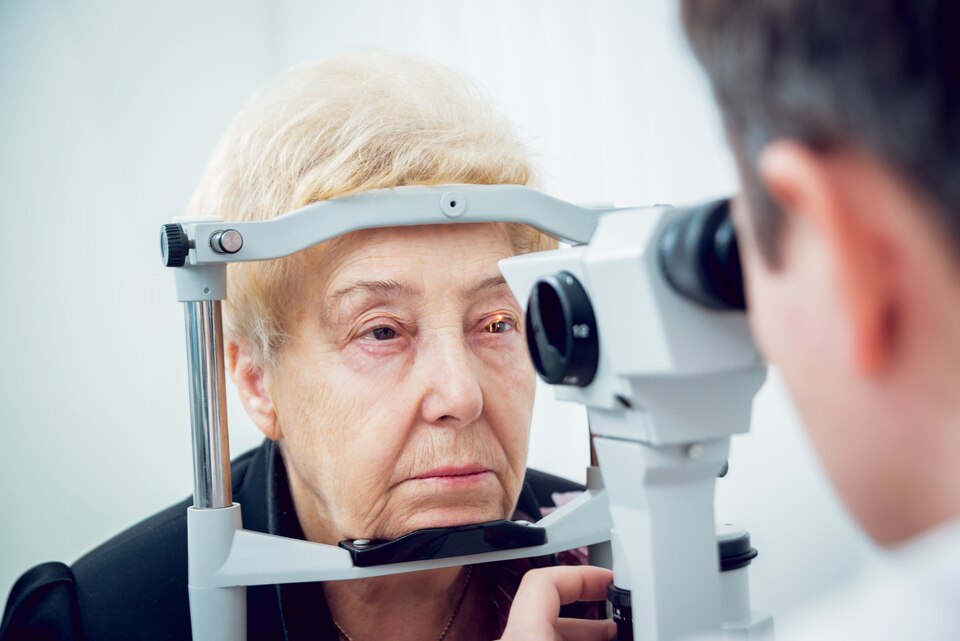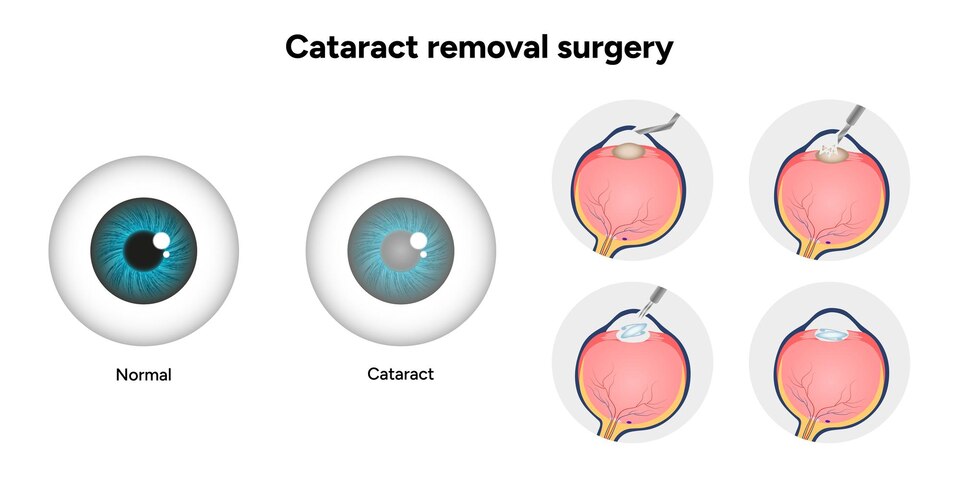Last updated on May 9th, 2025 at 06:05 pm
Introduction to Cataracts
Cataracts are a common age-related eye condition that affects millions of people worldwide. They happen when the eye’s natural lens becomes cloudy or opaque, which causes a progressive deterioration in vision quality. Although cataracts are often associated with older adults, they can develop at any age, even in young children. The good news is that cataract surgery is a highly effective treatment, and early detection can significantly improve the outcome. In this article, we will discuss the early stages of cataracts and the types. We will also explore the symptoms, causes, diagnosis, and treatment options for early cataracts, as well as the effectiveness of cataract eye drops and lifestyle changes to prevent or slow down the progression of this eye condition.
What are Early Stages of Cataracts?
The early stages of cataracts are the initial phase of the condition where the lens of the eye begins to become cloudy or less transparent. This stage is also known as the “incipient” stage, and it may not cause any noticeable vision problems. However, as the cataract continues to develop, the lens becomes more opaque, and the symptoms worsen. It is crucial to recognize the early signs of cataracts to seek appropriate treatment and maintain good eye health.
Symptoms of Early Cataracts
In the early stages of cataract development, the symptoms may be subtle and not immediately noticeable. Some common signs of early cataracts include:
- Blurred or hazy vision: One of the first symptoms of early cataracts is a slight blurring or haziness in your vision. The inability to read, drive, or recognise faces may result from this.
- Increased glare and sensitivity to light: As cataracts develop, the lens becomes less transparent, causing light to scatter within the eye. This can result in increased glare and sensitivity to bright lights, especially at night.
- Difficulty seeing in low light conditions: Early cataracts may cause you to struggle with seeing clearly in dimly lit environments, such as reading in a dim room or navigating at night.
- Changes in color perception: can cause colors to appear duller or less vibrant, making it difficult to distinguish between similar shades.
- Frequent changes in eyeglass prescription: If you notice that your eyeglass prescription is changing more frequently than usual, it could be a sign of early.
 Types of Cataracts – Immature Cataract, Complicated Cataract, Cataract Lens
Types of Cataracts – Immature Cataract, Complicated Cataract, Cataract Lens
There are several types of cataract, and each has its unique characteristics and symptoms. Some common types include:
- Immature Cataract: In the early stages of cataract development, the lens is only partially opaque. This is called an immature cataract. The symptoms of an immature cataract are typically mild and may not significantly impact your daily activities.
- Complicated Cataract: A complicated cataract is a type of cataract that develops as a result of another eye condition or disease, such as uveitis, glaucoma, or diabetic retinopathy. Complicated cataracts often develop more rapidly and may cause more severe vision problems than other types of cataracts.
- Cataract Lens: A cataract lens refers to the cloudy lens within the eye that is causing the vision problems. There are different types of cataract lenses based on the location and severity of the lens opacification. These include nuclear cataracts (which affect the central part of the lens), cortical cataracts (which affect the outer edges of the lens), and posterior subcapsular cataracts (which develop at the back of the lens).
Glaucoma vs Cataract: Which Eye Condition Deserves More Attention?
Causes of Early Cataracts
There are several factors that can contribute to the development of early cataracts. Some common causes include:
- Aging: As we age, the proteins in the lens of the eye can begin to break down, causing the lens to become less transparent and more susceptible to cataract formation.
- Genetics: A family history of cataracts can increase your risk of developing the condition.
Ultraviolet (UV) radiation exposure: Prolonged exposure to the sun’s UV rays can damage the proteins in the lens, leading to the development of cataracts. - Diabetes: People with diabetes are at a higher risk of developing cataracts due to high blood sugar levels, which can damage the lens of the eye.
- Smoking: Cigarette smoke contains harmful chemicals that can damage the lens, increasing the risk of cataract development.
- Eye injuries or surgeries: Trauma to the eye or previous eye surgeries can cause damage to the lens, making it more likely for cataracts to form.
Diagnosis and Treatment Options for Early Cataracts
If you suspect that you may have early cataracts, it is essential to consult an eye care professional for a comprehensive eye exam. During the examination, your eye doctor will assess your lens for signs of cataract development and determine the severity of the condition.
In the early stages of cataracts, treatment may not be necessary, as the symptoms may be mild and not significantly impact your daily activities. However, your eye doctor may recommend certain lifestyle changes or specific eyeglass lenses to help improve your vision and reduce glare.
If the cataract progresses and significantly impacts your vision, your eye doctor may recommend cataract surgery. This procedure involves removing the cloudy lens and replacing it with a clear, artificial lens called an intraocular lens (IOL). Cataract surgery is a highly effective treatment with a high success rate and a low risk of complications.
 Prevention of Early Cataracts
Prevention of Early Cataracts
While the development of cataracts is often a natural part of the aging process, there are steps you can take to reduce your risk and potentially slow down the progression of the condition:
- Protect your eyes from UV exposure: Wearing sunglasses with 100% UV protection can help shield your eyes from harmful UV rays and reduce your risk of cataract development.
- Manage diabetes: If you have diabetes, maintaining healthy blood sugar levels and regularly monitoring your eye health can help prevent cataract formation.
- Quit smoking: Giving up smoking can significantly reduce your risk of cataract development and improve your overall health.
- Eat a healthy diet: Consuming a diet rich in antioxidants, such as vitamins C and E, can help protect your eyes from damage and reduce your risk of cataracts.
- Limit alcohol consumption: Excessive alcohol consumption can increase your risk of cataracts, so it’s essential to drink in moderation.
Cataract Eye Drops and Their Effectiveness
There are several over-the-counter cataract eye drops available that claim to dissolve or reduce the size of cataracts. These drops typically contain a compound called N-Acetylcarnosine (NAC), which is thought to have antioxidant properties that may help break down the proteins causing the lens opacity.
However, the effectiveness of cataract eye drops is still a topic of debate among eye care professionals. While some studies have shown promising results, others have found little to no improvement in cataract size or vision after using these drops. As a result, cataract eye drops should not be considered a substitute for a comprehensive eye exam and professional treatment.
Lifestyle Changes for Early Cataracts
In addition to the prevention strategies mentioned earlier, making certain lifestyle changes can help improve your overall eye health and potentially slow down the progression of early cataracts:
- Regular exercise: Engaging in regular physical activity can help improve overall health, reduce the risk of chronic diseases, and promote healthy blood circulation, which is essential for maintaining good eye health.
- Sleep: Ensuring that you get enough quality sleep each night can help promote good eye health, as the eyes repair and regenerate during sleep.
- Manage stress: Chronic stress can negatively impact your overall health, including your eyes. Practicing stress reduction techniques, such as meditation, deep breathing exercises, or yoga, can help reduce stress and promote good eye health.
- Healthy diet: Consuming a diet rich in fruits, vegetables, and omega-3 fatty acids can help promote good eye health and reduce the risk of cataract development.
- Regular eye exams: Regular comprehensive eye exams can help detect early signs of cataracts and other eye conditions, allowing for prompt treatment and better outcomes.
Conclusion – Takeaway Tips for Early Cataracts
In summary, early cataracts are the initial phase of cataract development, where the lens of the eye becomes cloudy or opaque, leading to a gradual decline in vision quality. Recognizing the symptoms and types of cataracts is crucial to seek appropriate treatment and maintain good eye health. While cataract surgery is a highly effective treatment for advanced cataracts, early stages of the condition may not require treatment, and certain lifestyle changes and prevention strategies can help slow down the progression of the condition. If you suspect you may have early cataracts, it is essential to consult an eye care professional for a comprehensive eye exam.
Takeaway tips for early cataracts:
- Recognize the symptoms of early cataracts, such as blurred vision, increased glare, and difficulty seeing in low-light conditions.
- Understand the types, including immature, complicated, and cataract lenses.
- Know the causes of early cataracts, such as aging, genetics, UV radiation exposure, diabetes, and smoking.
- Seek professional diagnosis and treatment options, such as lifestyle changes or cataract surgery.
- Practice prevention strategies, such as wearing sunglasses, managing diabetes, quitting smoking, eating a healthy diet, and limiting alcohol consumption.
- Consider regular comprehensive eye exams to detect early signs of cataracts and other eye conditions.
In conclusion, early detection and treatment of cataracts are essential for maintaining good eye health and quality of life. By understanding the symptoms, types, causes, and prevention strategies of early cataracts, individuals can take proactive steps to protect their eyes and potentially slow down the progression of this common eye condition.
Also Read: Must follow Precautions for before and after of a laser cataract surgery
Call To Action
For access to more such interesting articles on healthcare, visit Medkart today!
